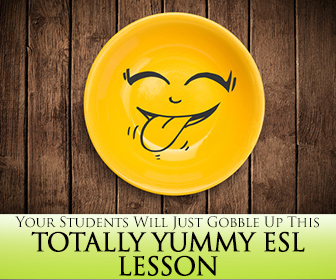The fact that everyone depends on food to survive is of no surprise to anyone. We need to eat and a lot of us also enjoy it, some of us more than others.
For this reason, the topic of food is always present in any and all ESL programs. These programs are designed to cover needs our ESL students might have abroad or when dealing with foreigners. Our students need to be able to talk about food and to describe it. Also, keep in mind what an important role meals play from the social point of view. We share meals to celebrate events and even to do business. So, if you think about it, our students might have a lot riding on a simple meal!

Help Your Students with Their Wining and Dining, with These Killer Tips on What to Teach
-
1
Asking About and Describing Food
The unknown can be scary for most of us. Dealing with something we are unfamiliar with can be a daunting task and when talking about unfamiliar food, it is no exception. All of us have a story or two about eating something we were a bit reluctant to try. A lot of times, these stories end well. After tasting whatever it is you are trying, you realize is is quite palatable or even yummy. Other times, however, we are faced with a very different situation. We try something and we don't like it at all. This is very hard to manage, but we will deal with this later. For now let's concentrate on asking about food and describing it.
Unfamiliar Food
When someone is unfamiliar with some type of food or drink, the best and most obvious way to handle this is to simply ask the host /hostess about it. Let your students know they should be careful not to insult anyone, so a good way to start would be by complimenting the host/hostess first, then ask about the food. Take a look at some examples.
This looks delicious/ fabulous/ incredible. May I ask what it is?
This look amazing! What are the main ingredients?
What a fabulous meal! How is this prepared?Describing Food
Hopefully your students will also have the opportunity to entertain others. In that case they need to practice describing food. Take a look at following examples.
Flavor: This is (a little/ very) sweet/salty/sour/ bitter/spicy/hot.
Temperature: It is hot/warm/chilled/cold
Texture: It is tender/ soft/ hard/ tough/ crunchy/ crispy
Comparisons: It tastes like …or It's like/ similar to … -
2
Declining Food and Drink
There will be times your students will need to say no to food or drink. Perhaps because they have eaten too much, or because they are sure they won't like it. Also many people suffer from different conditions that don't allow them to eat certain foods. There can be many reasons, and whatever the reason is, they have to be ready to say, “no thank you”.
Medical Conditions.
It looks delicious but I'm allergic to …
This looks great but I have/am … and I can't eat/drink...It Is Too Much
This is incredible but I can't take another bite.
Everything is so delicious but I'm full.There Is Something They Don't Want to Try
Some foods with their flavors, smells and textures are way out of our comfort zone. This can happen to anyone and it is a delicate situation. After all, we don't want anyone to feel insulted or rejected. Tell you student there are different strategies for this. They can come clean with expressions like:
It looks very delicious but I'm afraid it is a bit too different from what I'm used to. Is it OK if I just have …?Another choice is to use an excuse like, allergies or that they are not hungry.
-
3
Asking for Seconds
Let's imagine another scenario, a much happier one for your students. They have been invited to a meal and everything is absolutely scrumptious. They are enjoying the food so much in fact, that they want more. Teach them the following expressions and they will be able to continue stuffing their faces.
This is amazing! May I have some more?
Incredible! Can I have seconds?
May I have another piece/ portion/ slice of …?
Sharing a meal with a nice group of people is always lovely. Help your students enjoy their social life.
Prepare them and encourage them to go to dinner parties and restaurants, to try new dishes and flavors. They'll thank you for it.
P.S. If you enjoyed this article, please help spread it by clicking one of those sharing buttons below. And if you are interested in more, you should follow our Facebook page where we share more about creative, non-boring ways to teach English.







